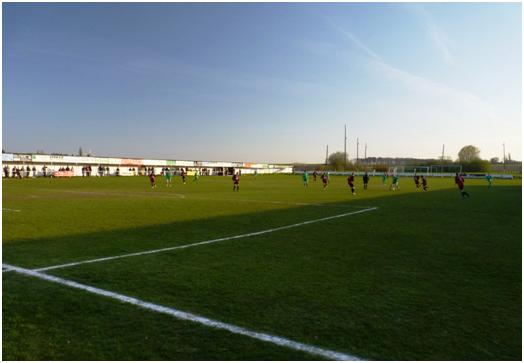Top of the Klasse.
Football wise, it has been a long winter. The combination of working away from home, and actually having the wife at home to visit on the weekends has put the longer trips out of my mind except when my wife wants me to take her into France, and then two times out of three this does not allow Football. At least the relative success of Cheltenham has meant that a period where I see them almost exclusively at the weekend,(with a diet of revisits in the general Manchester region during the week) was more than palatable.
Seasons change, as does home club form. At the time of writing, Cheltenham have not scored in five games and 77 minutes. It is a testimony to their earlier season form that even this record is not enough to take them out of the play off zone. With Cheltenham playing at Southend on a Friday night (no goals for us there),my first thought was to use the Channel Tunnel for the weekend, especially as I had an old ticket with the validity about to run out. I booked Monday off work, mainly because I did not want to drive from Belgium to Manchester in an evening. As it happened, the validity of my Eurotunnel ticket ended not on the Sunday, but the Saturday, and due to it being the first week of school holidays, there was almost no availability on the tunnel anyway. So my tunnel trip was instead scheduled for 25th March, when I did indeed drive from Wingene in Belgium, to my flat in Didsbury, arriving back at around 23.30.
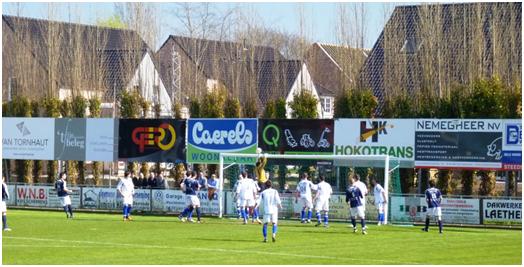
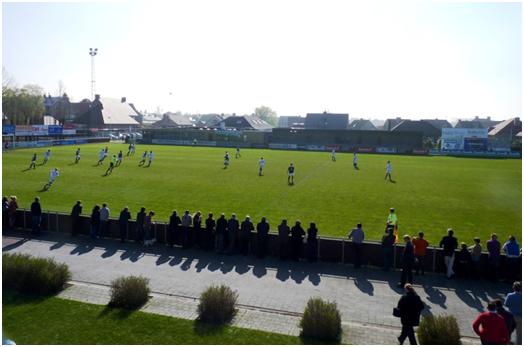
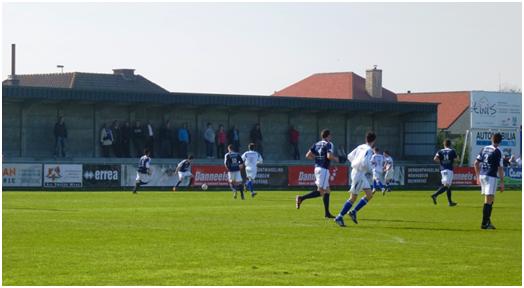
One I visited earlier KVC Wingene in action against Blue Star Poperinge.
I was tempted but not too tempted by a variety of possibilities for the weekend, as March gave way to April but this left me too indecisive and as often happens with the “cheapo” air fares, one needs to pick up straight away. Anyway, a short trip with little time between the games for sightseeing is best done to the old familiar countries, such as Belgium, the Netherlands and Germany. Still, fares were showing rather high, and I almost gave up the idea until I saw that I could fly BA to Amsterdam within a sensible budget. If I’d driven with Eurotunnel, then I would have tried to start early enough to get into the Netherlands, so this was ideal. Although not taking the trip, Paul generously allowed me to stop over at his place and park the car there, meaning I had just the slight target of the 05.46 train from Horley to catch my 07.20 flight at Gatwick.
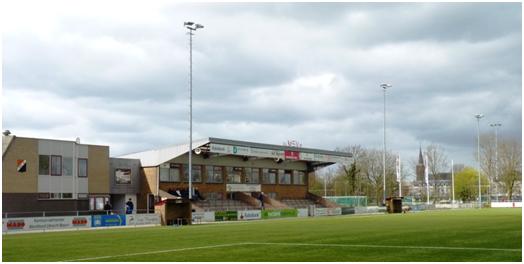
Not the Montfoort Stadium. Instead the ground of neighbours MSV ’19
Even with the hour of time difference and the length of walk at Schiphol from Plane to Car Hire, I had some time to spare, and wandered into Utrecht for a while before heading to the match. In the Netherlands, the cities are generally more interesting than the towns. Indeed, most small towns in the Netherlands are much of a muchness, and somewhat dull. Pleasant (but dull) housing surrounds a pleasant (but dull) shopping area with a few small bars and restaurants and at least one supermarket. Driving must be done slowly, as it is never clear who has priority at a junction, but most cyclists assume that they own the road. It is, of course, possible that they do. The football grounds are almost always on the edge of town. Montfoort is no exception in these regards, although a couple of church spires and a windmill gave some respite on the skyline.
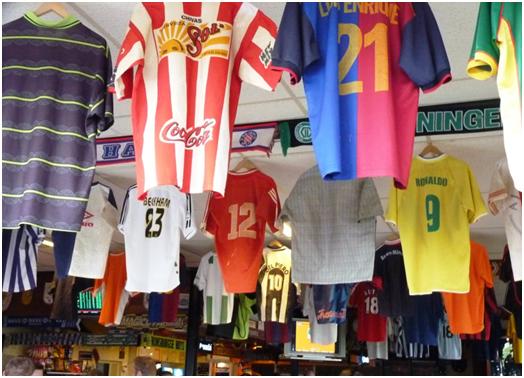
A football club bar should celebrate football, at least that’s what they think in Montfoort
Arriving at the grounds, one sees a neat small ground with a modern stand. Above the stand are the letters MSV’19. This is not the club I am going to see. Research shows that MSV play at the fourth level of regional Sunday football so a ground with its own stand is quite something. Next to the MSV ground is a sports hall, and walking past the sports hall, one gets to Sportpark Hofland, home of vv Montfoort. This again is typical of the beast. Most of the surrounds of the ground are flat, but paved. On one side, a small stand has a small amount of elevation giving those inside a line of sight just above the benches. These seats, maybe 200 or so, provide all the cover. Each side of the stand are slightly raised grass banks, while in one corner, there is the clubhouse. This is typical of the type, Netherlands club bars are generally quite spacious, with a large bar area for drink, and food from a separate counter. There are more tables and chairs outside, in an area slightly enclosed. You can drink beer within sight of the pitch from this area, or through the clubhouse windows, but views will not be the best. You cannot take the beer to the other parts of the ground. I noticed that when someone walked out of the zone carrying the drink, they were quickly stopped by the stewards who had a quiet word after which the spectator returned to where he could legitimately finish his drink. While the professional leagues in the Netherlands suffer from a degree of hooliganism which goes beyond that remaining in Britain, the non-League game is one of tolerance, and four figure crowds can quite happily stand around the ground without even trying to goad the opposition.
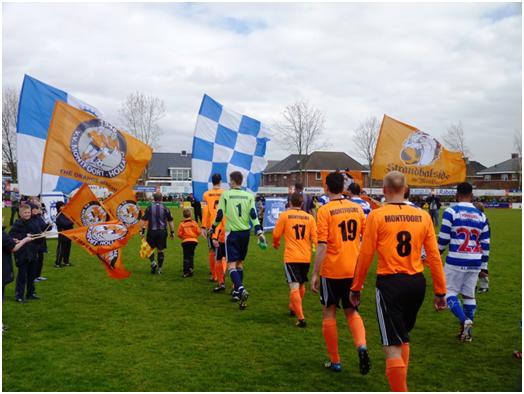
Welcome to Montfoort. The teams enter the field to both sets of banners. Fans with a long memory will recognise the two footballers on the Montfoort badge from so many old programmes. Students of geography may note the wording VV Montfoort. Holland. Normally, the pedantic in me corrects the name Holland except in the two provinces of the Netherlands which are historically Holland. Montfoort is in Utrecht province, although close to the border with Zuidholland
Football in the Netherlands, below the two professional divisions is split into Saturday and Sunday football, with supposedly equal structures in each. This is the second season in which the top division of these two leagues is call Topklasse, and is national. The “Amateur Champion” is now decided by an end of season play off between the two TopKlasse champions. The winner of this can be promoted to the professional league, if they desire and have suitable facilities. The runner up can take the place if the winner declines. IN practise, there is next to no movement between the professional and amateur leagues.
The split into the Saturday and Sunday games is mainly on religious grounds. The protestants would never play on Sundays, whereas the Catholics always do, (this is true across much of Western Europe, countries are predominantly Roman Catholic are also predominantly Sunday football (or more recently Saturday night)). Saturday afternoon comes from the protestant communities. In the Netherlands there are more Saturday clubs towards the West, whereas in the area close to the German border, the Sunday leagues hold sway. With the West being more densely populated, there is a tendency for Saturday football to hold sway.
Apart from the National final, the Saturday and Sunday clubs can meet in the National and District cups. The rule for such meetings is that a Saturday club can refuse to play on a Sunday, but a Sunday club cannot refuse to play Saturday. Both legs of the national final are always on Saturdays.
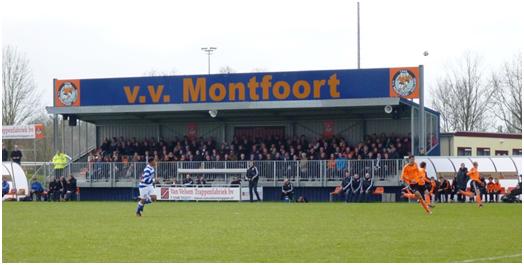
Spakenburg are one of the top amateur teams in the Netherlands, and have won the overall championship 4 times, last season they came second in the Saturday Topklasse behind local rivals (the grounds are adjacent), IJsselmeervogels. Their neighbours went on to become overall champions, their 7th title. The derby match between these two had become the stuff of legends, and a capacity 8,500 saw the match played a week before my arrival. As a Spakenburg fan said to me “We did not play well, but we won”. This meant that Spakenburg went to Montfoort as top of the league, and with quite a following, two supporters coaches were parked outside the grounds, and judging by noise and colours, they provided over 50% of the spectators. Montfoort have been one of the beneficiaries of recent changes. They were not in the old Hoofdklasse before the Topklasse was formed, and after finishing fourth at the Eerste Klasse level, they won promotion after a series of play offs. Last season they went up again, and again it was via play offs, and not the one direct promotion place. This season, it appears as if the rapid rise is going to end, and they are secure in the relegation zone.
Not surprisingly, Spakenburg dominated the game. They managed to hit the cross bar no less than three times, while home keeper Johan Verkerk was announced as man of the match. Then, just after an announcement of a minimum four minutes injury time, Montfoort attacked on the break, the ball dropped to Chanan Brandsma on the left side of the penalty box, he kept his nerve and put the home side ahead. Spakenburg were shocked to be behind in a game which they should have comfortably won. From the kick off, a player went on a run down the wing and was brought down, the free kick was blocked for a throw on, the throw on was blocked for a corner. The corner was long, and Roy de Vies found space to sweep in a shot. 1-1. The result really did not help either side, with four games to play. Spakenburg lost top spot to Rijnsburgse Boys, while Montfoort are still four points short of the play-off position in their attempt to avoid the drop.
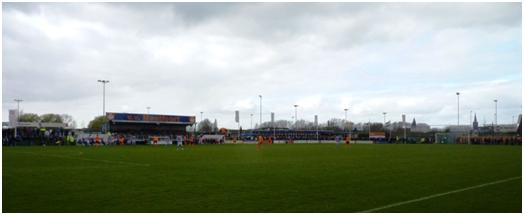
Admission to the ground was 8, and a free A5 programme was available. This consists of four pages of text, mainly squads, league tables and fixtures, surrounded by a glossy professionally print cover and advertising. Around 1250 turned out for the game. I was told that the creation of Topklasse had done a lot for this level of football, with a higher quality of football and much better crowds. Although both Spakenburg and Rijnsburgse Boys were rumoured to apply for promotion last season, I do not think either want to go up. Last season, Oss were promoted despite losing both legs of the final to IJsselmeervogels. Oss had until recently been in the league, and anyway, there was no relegated club as RBC had been declared bankrupt. The main point against taking promotion is the amount of work required to create a suitable stadium, and the costs of running a professional team. Most of the professional clubs carry significant debt, while generally the “amateurs”, (Topklasse is officially semi-professional), can balance their books.
Two weeks after this trip, Rijnsburge were held at Noordwijk, while Spakenburg have played twice more since my visit to Montfoort and scored 12 goals. Spakenburg therefore are back on top as I publish this, but Montfoort are now beyond hope, with relegation confirmed.
It goes without saying that I was not going to take a flight in search of just a single game of football, and I did not stop at Montfoort, instead I headed south and to Belgium. A variety of factors make this the most popular destination for groundhoppers heading regularly into European football. The factors tend to be ease of access, quality and variety of beer, chips with mayonnaise, and only then the football. Belgium towns have kept some of the idiosyncrasies lost in the Netherlands. Most towns are centred on a town square with one or two old buildings and a mixture of bars, restaurants and banks. Themain shopping areas tend to be on radial roads leading away from this square, and while the outskirts are not far different to suburbia elsewhere, the houses are certainly not all the same. On the contrary, one never sees two identical buildings next to each other. Even closer to the town, where at first glance one may find a row of similar terraced houses, a closer look will show that each has a little difference to its neighbour, even if this is just a decoration above the windows. It is this style, a homogenised non conformity, that best sums up Belgium.
As in the Netherlands, the professional league consists of two national divisions. The difference here is that while regionalism and semi-professionalism certainly starts at level 3, it is a more gradual transition. There is also a great deal of movement up and down the divisions with no artificial barrier placed in the way of promotion. The League comprises of four divisions, Division One has 16 teams, which means after 30 matches, they go into play off groups of unnecessary complexity. Most people preferred the straight 18 team league, but of course the increase in number of meetings between the top six, and the television contract for these hold sway. Division Two has 18 teams, and Division Three has 36, in two regions of 18 teams each. One team from team from each is promoted, while three enter play offs with one team from the higher division. There are two direct relegation places and one relegation play off place from each. Division four has four divisions of 16, with the same promotion structure, but no less than three direct relegation places, and one place again in the play offs. Up to 14 teams can lose their fourth division place.
Having gone weeks since the trip, without the time or impetus to finish the article, I am settling for brief notes and photographs from each of the three Belgium clubs visited on the trip.
First up was Leopoldsburg. As a club that bears my name, I thought it appropriate for what was actually my 200th ground in the country. Leopoldsburg also is one of those clubs that seems to always be in the bottom two divisions of the Belgium League. The club is known as KESK Leopoldsburg. The first “K” stands for Koninklijk, (it means royal), which can be seen in the name of most Belgium clubs with over 50 years of history. The “K” was actually awarded to the Excelsior FC Heppen in 1993. They merged with the more recently formed SK Strooiendorp Leopoldsburg in 1999. The new club kept those things that were of most value to Heppen, the “K”, the word Excelsior, and the Stamnummer (it may only be 3904, but it is still nearly 5000 less than the other club in the merger). I do not know when a much earlier Leopoldsburg club (with the far more impressive Stamnummer of 288) disappeared from view, but as the Belgiums tend to recycle their grounds, it would not be a surprise if KESK’s secondary ground had been used by this club. As it is, their Heidestraat ground is actually in Heppen, a good couple of miles from the centre of Leopoldsburg. The full name of the club is Koninklijk Excelsior Sportkring Leopoldsburg.
The ground is on the edge of town, nearly merging into the woods. At one end it has a neat stand built over a bar right up at one end of the pitch. The same side has a little cover in front of the dressing rooms, and a traditional single story long and narrow “cantine” (translates as bar) at the other end
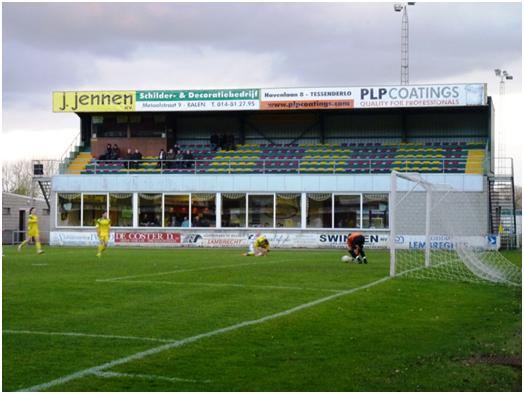
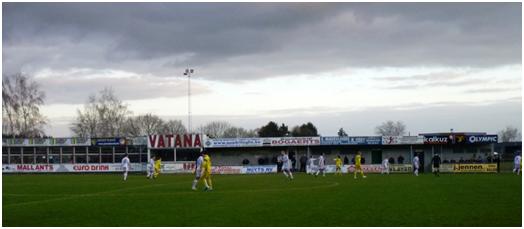
I watched most of the game from the far side, where low cover runs the full length of the ground. The small structure visible at the end is an additional bar, allowing those in the stand to buy beer.
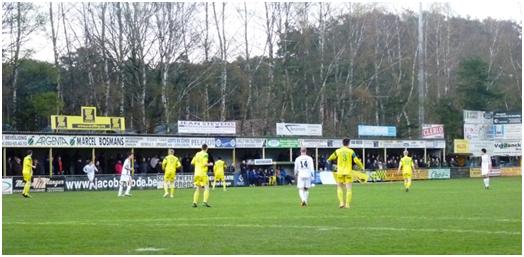
Admission was 8, and the crowd was quite small, I estimated it around 150. There was no programme as such, but an A4 printed sheet including the team names was made freely available around 20 minutes before kick-off. Quite a few of the fans came from the away team, Witgoor Sport Dessel. I had to question them as one of the names on the teamsheet had the wrong number. This makes them ask what you are doing there. It is not always easy to explain, even though every club in Belgium at this level has seen occasional English and German groundhoppers in attendance. As one I saw Witgoor at home earlier in the season, it was not a very exciting game, and was settled in Witgoor’s favour by a single late goal. The fans I had talked to had no hesitation in pointing out that scorer on this occasion, Alban Grepi was the player I had asked about.
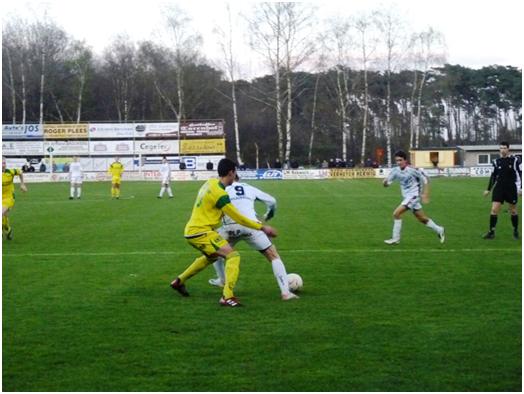
It was the Belgium fourth division again the following day. The name Everbeur belongs to a small part of the small town of Averbode. Their football team started in the 1930s, joining the Belgium FA in 1932, (there were local unaffiliated competitions as well in those days), and after periods in more local leagues, making their way into the 3rd level of the provincial League (Brabant) in 1935. They rose to the second level in 1937 and to the first provincial league in 1943. A season later they reached the National League. 1944-5 season was lost to the war, and Everbeur stayed in the National League until 1951. After two seasons back in the provincial league, they were again promoted in 1953, but just before the season started, the Belgium FA hit them with a bombshell, no less than 13 of their players were suspended for taking illegal payments, (which means any payment at all, as they were all amateurs). With the guts ripped out of the team, they were relegated at the end of the season. They also lost their ground at this point and almost went out of existence. Still, they ploughed on, despite relegation at the end of 56-7 season which after which it was 51 seasons until they again reached the top provincial level. Their lowest point were the seasons 1989-91, spent in the fourth provincial league. There is no further down to go.
Slowly, their fortunes improved, but they were still at the third provincial league until 2006. Then three rapid promotions, 2006, 2008 and 2010 and they are back in the league for the first time since that disastrous 1953 season. They club had moved to their current home in 1978, and adopted the name K. Everbeur Sports Averbode in 2005.
Today the ground is next to the local sports centre, and this provides some shelter for the standing spectator, plus of course, the obligatory bar. The seating stand, a modern steel construction is on the opposite side. When I arrived at the ground, it seemed likely they would again change division in an even year, but this time, it would be a relegation.

Their hopes were not improved when within 30 seconds of the kick off, visitors KFC Sint-Lenaarts were 1-0 ahead. There was a fair crowd here, around 300 on a sunny afternoon. The admission price was 9. As at other matches, an A4 printed sheet was made available with the teams just before kickoff. As it turned out, this was intended as an insert into a full A4 programme which was carried around the ground to those who wanted it during the first half. No specific price appeared to be charged for this, but the programmes were only given to those who also bought a scratch card.
The match turned on the referee’s decisions. In the 26th minute, the visiting keeper managed to foul a home forward as he broke through. The referee gave a penalty and sent the keeper off. St Lenaarts had a substitute keeper to bring on, but this still means over an hour with only 10 men, and Everbeur had pulled level from this first penalty.
Not content with this, the referee awarded not one, but two penalties to Everbeur in the second half.
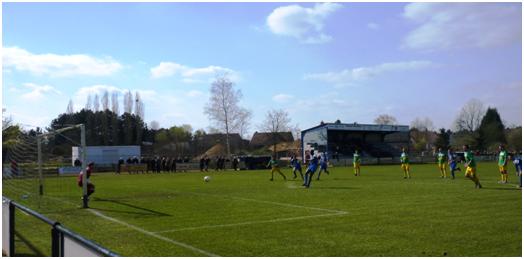
Having scored from the penalty spot in the first half, Shabi misses this chance to put his side 2-1 up with the second penalty.
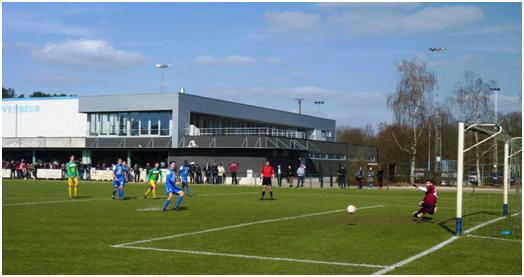
With then minutes to play, Everbeur take the games third penalty, van Aerschot putting his team 2-1 ahead.
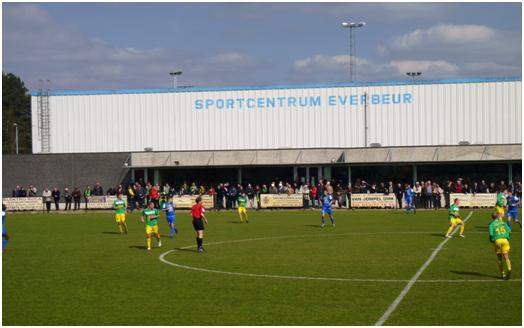
The Sportcentrum side and cover. The bar is within the Sportcentrum
With the visitors pushing forward to try and make up for this, Everbeur scored again in the final minute, recording a 3-1 win. Since then they have won two successive away matches, both against teams in the relegation zone, which have pulled them above the danger zone and makes survival at this level for another season more probable.
I was fortunate, I was not returning to the UK until Monday morning, and the fixtures had provided me with an extra game, albeit in the depths of the second provincial league. Although it was still a Brabant club, I first had to find my way around the Brussels Ring at a busy time of a Sunday evening. This was one of the times the satnav system was not playing ball, insisting that the roadname I gave for the ground was in fact a small driveway leading into a farm. Having looked up and down the roads in both directions and found nothing, I tried asking three small children (about 10 years old, I guess) playing ball in said driveway. One of them told me, in a language I understood (which means neither French, nor Flemish), to go back to the main road turn right and head to the cross roads. From this direction, the ground was clearly sighted, and it was still ten minutes before the start when I entered, although not through this gate.
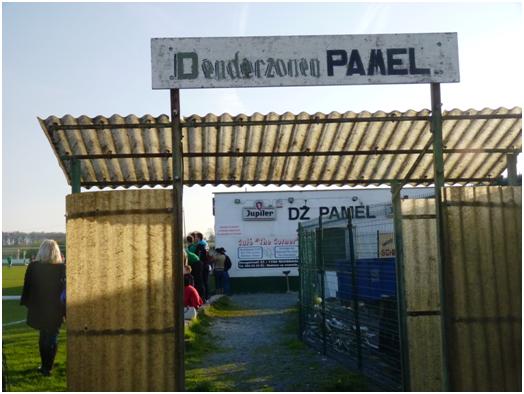
The entrance actually must once have been connected to the road by a path, but this has not been closed off by a business, meaning a walk around the businesses and the side of a field to enter.
The home side, Denderzonen Pamel, were promoted last season and have accumulated just about enough points to ensure survival. The visitors, US Rebecquoise, still had hope of sneaking into the play offs, but it would depend on others as well as themselves. Still, they did their bit at the start of this game, 1-0 up with a third minute penalty, they tore through the home team to be 3-0up in just 21 minutes
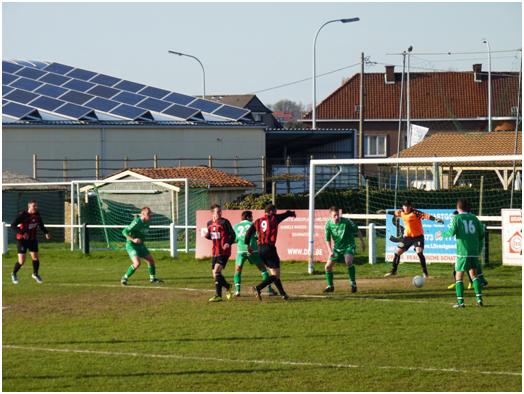
No. 9 for Rebecquoise, Bert Sleewagen opened the scoring with a third minute penalty, and here in the 21st minute, he is seen scoring his team’s third goal.
It cost 6 to enter the ground, around 150 people were present. There was a cantine/bar by the entrance, and the fact that a team sheet was given out as I entered the ground meant no searching for the official lists and time for a quick beer before kickoff.
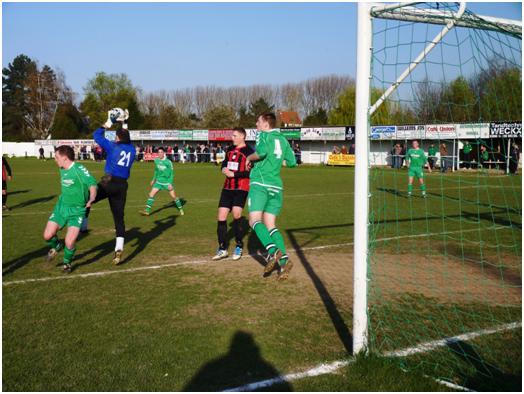
Low cover, filled most of the length of the far side.
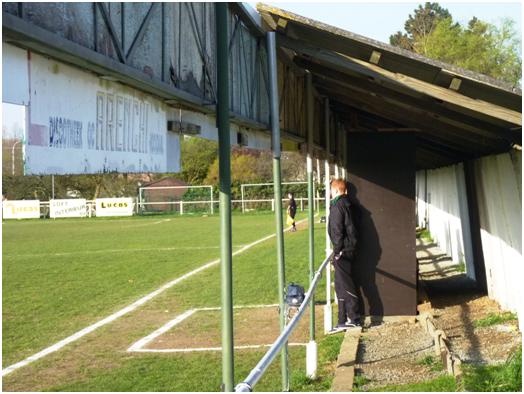
Not all the cover is in good repair the partial blockage of the pathway is the home “dug out”
With five minutes to go to half time, the game took an unexpected turn, Denderzonen Pamel pulled a goal back, and then a minute later were awarded a penalty
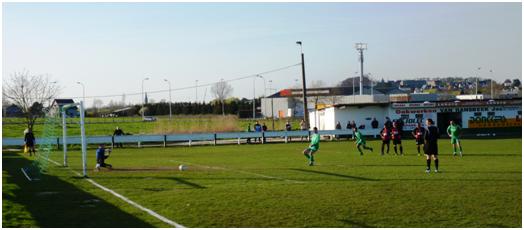
Damien Wets scores from the spot. Denderzonen Pamel 2-3 US Rebecquoise. Four minutes before half time, but as it turns out, the final goal.
Early in the second half, I am near the corner flag, when Rebecquoise’s Jeremy Paduwat commits a foul and receives his yellow card. He then says something, loud enough for me to hear, but in a language I do not understand (i.e. French or Flemish). It is enough to make a few young ladies (probably players’ wives or girlfriends) by the clubhouse door actually gasp in shock. Paduwat then just walks to the dressing rooms, never glancing back to see the inevitable red card. I imagine that he got some stick himself from his manager later, as down to ten men, it was a constant struggle for Rebecquoise, once so solidly in command to hold onto the points. There are no goals in the second half, but just before the end, the numbers are levelled again when a second booking causes Pamel’s Jeroen Walravens to leave the field.
